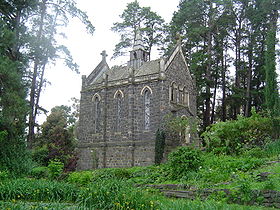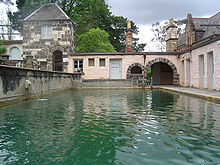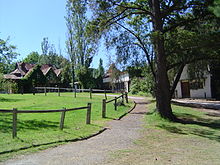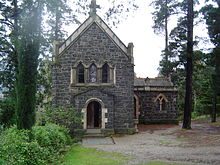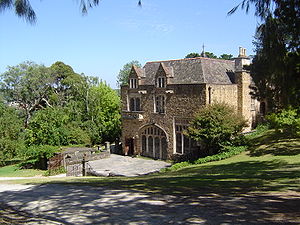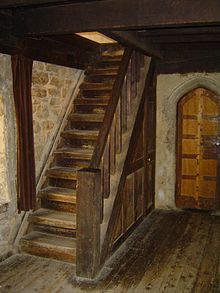- Montsalvat
-
Montsalvat is an artist colony in Eltham, Victoria, Australia, established by Justus Jorgensen in 1934. It is home to over a dozen buildings, houses and halls set amongst richly established gardens on 48,562 m2 (12 acres) of land.[1] The colony of Montsalvat has a detailed history that reflects the life of Justus Jörgensen and his friends and family; there is also a legend behind its name, while its buildings and gardens are steeped in the art and culture of Melbourne and its surroundings.
Visitors can pay a small fee to walk throughout the colony's historical gardens, artists' houses/workshops and explore the surrounding buildings. All of the buildings on the site were designed and built by residents with locally available materials, from various sources. The Great Hall offers an extensive network of spaces from extravagant halls and vast exhibition spaces, to small corridors and tiny balconies overlooking the gardens.
Currently Montsalvat's grounds and buildings are mostly used for exhibitions, performances, conferences, seminars, weddings and receptions; however, many artists (such as Luthiers, Jewelers, Painters, Sculptors and a Writer) continue to reside in Montsalvat. Several classes on various disciplines of art are offered year round by the resident artists.
Contents
Etymology
The name Montsalvat features in both German and English mythology. In the opera "Parsifal", by German composer Richard Wagner, Montsalvat is the castle, built by Titurel, where the Holy Grail is protected; and in his namesake opera, Lohengrin (in Act III) sings of it as home. In the English legend of "King Arthur and the Knights of the Round Table", Montsalvat is mentioned as the home of the Holy Grail. Though established only in 1934, Montsalvat has created its own myths and legends.[2]
History
Justus Jörgensen
Montsalvat is the creation of Justus Jörgensen and the inspired work of many hands. Born in 1894, Jörgensen trained as an architect with a Melbourne firm of architects, Schreiber & Co. Later, he turned his talents to painting, enrolling at the National Gallery School of Art in Melbourne, whose principal was a leading member of the Heidelberg School of Artists, Frederick McCubbin. In 1917, after hearing an important lecture by the artist Max Meldrum, Jörgensen decided to join the Meldrum Studio.
In 1924 Jörgensen married a medical student from Brisbane, Lillian Smith. In the same year the couple travelled to Europe with a group of artist friends including John and Polly Farmer, Colin Colahan and Archie Colquhoun. The group painted their way across Italy, Spain, France and England. In their travels they visited many of the great European Galleries to study the old and modern masters of European painting. Meldrum joined the group while they were painting in Cassis, a small French village near the Mediterranean coast. Later, some of them moved to Paris where Jörgensen established himself in a studio at 147 Rue Broca in the 13th Arrondissement.
He returned to Australia in 1929. During this period, Jörgensen enjoyed considerable success both in Paris and London, with exhibitions at several major galleries including being hung at the prestigious Royal Academy Summer Exhibition in both 1926 and 1927, a rare honor for an Australian. The influences of this period in Europe are apparent both in his painting and in the architecture of Montsalvat. Jörgensen bought a home and studio in the Melbourne bayside suburb of Brighton and later leased an old warehouse in Queen Street, Melbourne as his city studio where he could work and teach.
In 1956 the studio had to be vacated when the building was demolished to make way for the Royal Automobile Club of Victoria (RACV). The Queen Street classes had attracted many students and the studio had become an important hub of intellectual and bohemian life in conservative Melbourne. Jörgensen had continued to accept architectural work and in 1934 while working on the design and construction of a studio in Eltham for the painter and cartoonist Percy Leason, he decided that it was here he wanted to live, and so the Montsalvat dream began. Jörgensen invited his students and friends to join him in Eltham where he harnessed their collective enthusiasm in the building of Montsalvat.
Among those early students and friends were author and critic Mervyn Skipper, his wife Lena and their three children - Helen, Sonia and Matcham. Arthor Munday, George Charlmers, Lesley Sinclair, Sue Vanderkelen, Ian Robertson, Helen Lempriere, John Smith, John Busst and Myra Skipper. Percy Leason and his family lived next door and then there were the many friends who came to join in the work and the camaraderie of the camp.[2] Two notable Australian artists said to be associated with Montsalvat were Leonard French and Albert Tucker.[3]
Early Montsalvat
The Eltham district had been settled since the 1850s; some of these early pioneers had used mud bricks to build their farmhouses, but the method had long been abandoned. Jörgensen saw value in the building technique. The local soils appeared suitable for both adobe (mudbrick) and pisé de terre (rammed earth) and it was cheap, so he set his students to work. He dispatched Arthur Munday, to the State Library in Melbourne to research the technique. There was little written material available, as the methods has been handed down from father to son. Arthur finally found in the writings of the ancient Roman historian Pliny some of the information they were looking for...
Slate for the roofs came from a friend's recently demolished house, discarded fire bricks, tiles and other material came from other sites. The recently demolished Bijou Theatre (in Bourke Street) proved a rich resource which provided the beautiful cast iron circular staircase, architrave mouldings and some of the doors and windows. Helen Lempriere's family donated materials and money to build the ornamental pond. The many doors that open onto the pond area are from the cubicles that were the students' bedrooms, which have now been combined into one long studio. (The original inhabitants' initials can be seen on the front doorstep of each room). The small bluestone tower, limestone studio and Long Gallery were added later to form the closed courtyard.[2]
The Great Hall
Work on the Great Hall began in 1938 with a local tradesman Len Jarrold as the leading hand. Jörgensen had originally designed a modest structure of mud brick, however during the excavation a reef of mudstone was uncovered. The unique ochre tones of the stone inspired Jörgensen to re-design and the resulting larger structure was the Great Hall. He was fortunate in that Whelan the Wreckers were demolishing the charming Royal Insurance Building which stood at 414, Collins Street, Melbourne,[4] which contained the limestone windows and the stone balconies carved in the Gothic manner, that now adorn the Great Hall and give it its unique character. Students carved other windows and the gargoyles, which incorporated the traditional grotesque faces as seen in medieval architecture.
Extra stone for the walls came from a nearby quarry and the bluestone, granite and limestone from demolition sites across Melbourne. Some of the flagstones and roofing slates had originally been shipped from Ireland and Wales as ballast aboard the sailing ships that serviced Australia in the 19th century.
At the outbreak of World War II, work on the Great Hall ceased. Some of the students enlisted in the armed forces while others assisted on the home front. Montsalvat was turned into a farm and market garden. Jörgensen and his now smaller 'team' turned their creative abilities to these new projects, building the barns and sheds. Materials were scarce, but they managed to scrounge odd bits and pieces - from discarded broken bricks and rusty galvanized iron to timber poles cut from the bush. Additional to the market garden was the dairy and poultry farm with the produce being sold through the local markets.
The Department of the Army took an interest and allowed a skilled joiner and cabinetmaker, Phil Taffe to help with the project. Phil, although almost blind, worked on the new buildings and helped make some of the refectory tables, stools, carved chairs and other furniture that can be seen in the Great Hall today.
After the war, work on the Great Hall and other building recommenced. The slate floor in the hall and the wooden floors above were finally put in place. Students were given the task of carving the corbels and other embellishments around the windows and doors as part of their training. Local tradesmen joined the team, as did some new students and aspiring artists fresh back from the horrors of the war, like Clifton Pugh, Gordon Ford and Joe Hannan and tradesmen Horry Judd, Bill Floyd, Wallt Stephens, Ken Howard, plus several refugees from Europe and Asia.[2]
Recent history and today
Montsalvat today is a place where emerging and established artists can present and perform their work. Its visual features are enjoyed by tourists from around the world, and it can be found listed in many major Melbourne tourist guides. Public events (including exhibitions and performances), Film and Photography, Celebrations and Gatherings of many types are held on the property and amongst its buildings frequently.[1]
- In 1975 Montsalvat became a Charitable Trust with Jörgensen's youngest son Sigmund as the chairman of the Trust and its administrator.
- In 1989 the work at Montsalvat was recognised by the Victorian Government when the property was placed on Heritage Victoria's Register, soon followed by a classification by the National Trust of Victoria.
- In October 1998 the Australian Heritage Commission included Montsalvat on the Australian Register of National Estate. (No. 100160)
- The Shire of Nillumbik council has also listed the property as a Heritage Place.
- In 2006, an unpaid tax debt forced the current administration to sell land in nearby Christmas Hills after a bitter fight with a Victorian State Government appointed administrator.[5]
Film and Still Photography
Montsalvat is a much sought after location for films and photography, and is used by many professionals and amateurs alike. Personal photography and art using the grounds and buildings as the subject matter is encouraged, however, commercial uses must first be negotiated as fees usually apply.
Montsalvat has been one of the filming locations for two vampire films, Thirst in 1979,[6] and Queen of the Damned.
Was used for the opening scenes of John D. Lamond's "Ozploitation" film, Felicity (1979).
Often used as a backdrop for locally produced pornography shoots.
Private and commercial gatherings
- The Great Hall, Long Gallery, Barn Gallery and Chapel are all frequented by private functions including Weddings and Receptions as well as Funeral Functions.
- Montsalvat houses facilities for Commercial gatherings such as Seminars and Conferences. Spaces can accommodate for up to 200 people, while formal meals can be provided for up to 120 guests.[1]
Arson and subsequent re-building
In 1996 the red brick barn/workshop/studio towards the entrance was subjected to arson and burnt down.[7] It was subsequently rebuilt and now forms the main entrance and exhibition space known as the Barn Gallery. This is now where the majority of exhibitions and performances are held today.
References
- ^ a b c Official Montsalvat site
- ^ a b c d Montsalvat - A Symphony of Mud and Stone, Sigmund Jörgensen (2001)
- ^ Melbourne Architecture by Philip Goad p.140
- ^ A City Lost and Found by Robyn Annear p.94
- ^ Theage.com
- ^ Kuipers, Richard (2009). "Thirst (1979)". National Film and Sound Archive website. National Film and Sound Archive. http://australianscreen.com.au/titles/thirst/. Retrieved 2009-06-21.
- ^ The age Metro 8 July 1996, p. B1
- State Library of Victoria - Historical Archives
- Book of Local History by John F. Wood
See also
- Art of Australia
- Box Hill artists' camp
- Fredrick Christmas
- Heide Museum of Modern Art in Bulleen, Victoria, Australia
- Heidelberg School
External links
Coordinates: 37°43′41″S 145°09′08″E / 37.7280°S 145.1521°E
Categories:- Melbourne culture
- Visitor attractions in Melbourne
- Artist collectives
Wikimedia Foundation. 2010.

